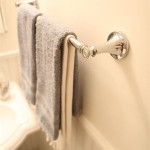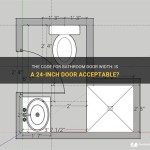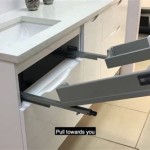Ontario Building Code Considerations for Bathroom Exhaust Fans in Taiwan: A Comparative Analysis
The implementation of building codes often varies significantly across international borders. While the Ontario Building Code (OBC) serves as a crucial regulatory framework for construction within the province of Ontario, Canada, its direct applicability in Taiwan is limited. However, examining the OBC's requirements for bathroom exhaust fans provides a valuable benchmark for assessing and potentially improving ventilation practices in Taiwanese construction, even if formal adoption is not intended. This article will explore key aspects of the OBC concerning bathroom exhaust fans and consider their relevance within the context of building practices and climate conditions prevalent in Taiwan.
The primary function of a bathroom exhaust fan, regardless of location, is to remove moisture and odors from the space. Excessive humidity can lead to mold growth, structural damage, and respiratory problems. Odor control ensures a comfortable and sanitary environment. The OBC provides specific guidelines to ensure these objectives are met effectively.
The focus is on ensuring that the requirements for adequate ventilation, moisture control, and the proper venting of exhaust air are consistently adhered to, creating healthier and more durable buildings. While Taiwan uses its own building regulations, primarily based on its National Standards (CNS), understanding the rationale and specific metrics employed in the OBC can inform best practices and highlight potential areas for improvement.
Minimum Exhaust Rate Requirements
The Ontario Building Code mandates specific minimum exhaust rates for bathrooms. These rates are typically expressed in cubic feet per minute (CFM) and are determined by the size of the bathroom or a prescribed intermittent exhaust rate. The goal is to efficiently remove moisture generated during showering, bathing, and other activities. The OBC typically references standards such as the Home Ventilating Institute (HVI) for certifying fan performance, ensuring that the stated CFM is accurately measured and achieved in real-world installations.
In contrast, Taiwanese building codes, based on CNS standards, also address ventilation requirements but may employ slightly different methodologies for determining adequate exhaust rates. Factors considered in both regions include the size of the bathroom, the frequency of use, and the expected moisture load. However, the specific CFM values and the testing procedures used to validate fan performance may differ. A comparative analysis of these standards is crucial to determine if Taiwanese requirements adequately address the needs of the local climate and building practices. Taiwan's subtropical climate, characterized by high humidity levels, may necessitate ventilation strategies that are at least as robust, if not more stringent, than those prescribed in the OBC.
Furthermore, consideration must be given to the impact of air conditioning systems, commonly used in Taiwan, on the overall ventilation strategy. Air conditioning can reduce humidity levels but may also impact the natural air exchange within the building. Therefore, the design of the bathroom exhaust system should be integrated with the overall building ventilation system to ensure effective moisture control.
The OBC specifies that the fan must be capable of exhausting air directly to the exterior. This requirement is designed to prevent moisture-laden air from being recirculated within the building, which would negate the benefits of the exhaust fan and potentially exacerbate mold growth problems. The code also addresses the proper installation of ductwork, including insulation requirements to prevent condensation within the duct and ensure efficient airflow. Duct length and the number of bends are also regulated to minimize static pressure loss and maintain the specified exhaust rate.
Taiwanese building codes may address similar concerns regarding exhaust ducting, but the specific requirements for insulation, duct materials, and installation methods may vary. It is essential to ensure that the Taiwanese regulations adequately address the potential for condensation and airflow restrictions, particularly in areas with high humidity and temperature fluctuations. The choice of duct materials should also be carefully considered, taking into account their resistance to corrosion and mold growth in the Taiwanese climate.
Proper Venting and Ductwork
The Ontario Building Code emphasizes the importance of proper venting to prevent the return of moist air into the building or adjacent spaces. Improper venting can lead to moisture damage, mold growth, and reduced energy efficiency. The code specifies that exhaust air must be discharged to the exterior of the building in a manner that prevents it from re-entering the building through windows, doors, or other openings. This typically involves using a dedicated exhaust duct that terminates at a location that is sufficiently far away from air intakes.
In addition, the OBC dictates the types of materials acceptable for use in exhaust ductwork. Typically, rigid metal ducts are preferred to flexible ducts, as they offer lower resistance to airflow and are less prone to kinking or collapsing. Insulated ducts are often required to prevent condensation, particularly in colder climates. The code also specifies the minimum diameter of the ductwork to ensure adequate airflow.
In the context of Taiwan, the selection of appropriate duct materials is of paramount importance due to the high humidity and potential for corrosion. The use of corrosion-resistant metals or plastics is advisable to ensure the long-term durability of the ventilation system. Furthermore, the design of the exhaust vent should take into account the prevailing wind direction and the potential for rainwater infiltration. A well-designed vent will prevent the backflow of moist air and minimize the risk of water damage.
The routing of ductwork should also be carefully planned to minimize the number of bends and the overall length of the duct. Sharp bends can significantly reduce airflow, and long ducts can increase static pressure loss. The use of smooth, gradual bends is recommended to optimize airflow efficiency. The installation of access panels may also be required to allow for periodic inspection and cleaning of the ductwork.
The OBC also addresses the issue of backdraft dampers. These dampers are designed to prevent the backflow of air into the bathroom when the exhaust fan is not operating. Backdraft dampers are particularly important in multi-story buildings, where pressure differences can cause air to flow in the wrong direction. The OBC specifies the type of backdraft damper required and its proper installation to ensure reliable operation.
Installation Requirements and Inspection
The Ontario Building Code sets stringent requirements for the installation of bathroom exhaust fans. These requirements cover aspects such as electrical safety, structural support, and proper sealing to prevent air leakage. Licensed electricians are typically required to install the electrical wiring for the fan, ensuring compliance with electrical codes and safety standards. The fan must be securely mounted to the building structure to prevent vibration and noise. The ductwork must be properly sealed to prevent air leakage and condensation.
In Taiwan, similar installation requirements exist, but the specific standards and enforcement mechanisms may differ. It is crucial to ensure that the installation of bathroom exhaust fans in Taiwan is performed by qualified professionals who are familiar with the local building codes and electrical regulations. Regular inspections are also necessary to verify that the installation meets the required standards and that the fan is operating effectively.
The OBC emphasizes the importance of proper sealing around the fan housing and ductwork to prevent air leakage. Air leakage can reduce the efficiency of the ventilation system and contribute to energy loss. The code specifies the types of sealants that can be used and the methods for applying them to ensure an airtight seal. This is particularly important in older buildings, where air leakage can be a significant problem.
The inspection process is a critical aspect of ensuring compliance with the OBC. Building inspectors are responsible for verifying that the bathroom exhaust fan is installed correctly and that it meets the required performance standards. They may conduct tests to measure the airflow rate and check for air leakage. Any deficiencies must be corrected before the building can be occupied.
Furthermore, the OBC provides guidance on the selection of energy-efficient exhaust fans. Energy-efficient fans can significantly reduce energy consumption and lower operating costs. The code specifies the minimum energy efficiency rating for bathroom exhaust fans and encourages the use of fans that are certified by programs such as ENERGY STAR. In Taiwan, there is increasing awareness of energy efficiency, and the adoption of similar standards for bathroom exhaust fans could lead to significant energy savings.
While the Ontario Building Code may not be directly applicable in Taiwan, its emphasis on ventilation rates, proper venting and ductwork, and installation requirements provides a valuable framework for evaluating and improving building practices in Taiwan. By considering the principles outlined in the OBC, Taiwanese building professionals can ensure that bathroom ventilation systems are designed and installed to effectively remove moisture and odors, promote healthy indoor air quality, and enhance the durability of buildings.
By drawing parallels between the OBC and Taiwanese standards, and by understanding the specific climate considerations in Taiwan, developers and builders can create better, healthier living environments. This proactive approach to building design will lead to increased resident satisfaction and improved building performance over the long term.

Ext External Mount Bathroom Fans Continental Fan

Bathroom Ventilation Fans Continental Fan

Commercial Tf Bathroom Fans Continental Fan

Ext External Mount Duct Fans Continental Fan

Axc In Line Duct Fans Continental Fan

How To Prevent Air Leakage Continental Fan

Cef Commercial Ceiling Exhaust Fans Continental Fan

Axp In Line Duct Fans Continental Fan

Axs Ec In Line Duct Fans Continental Fan

Mbi Centrifugal In Line Fans Continental Fan
Related Posts







